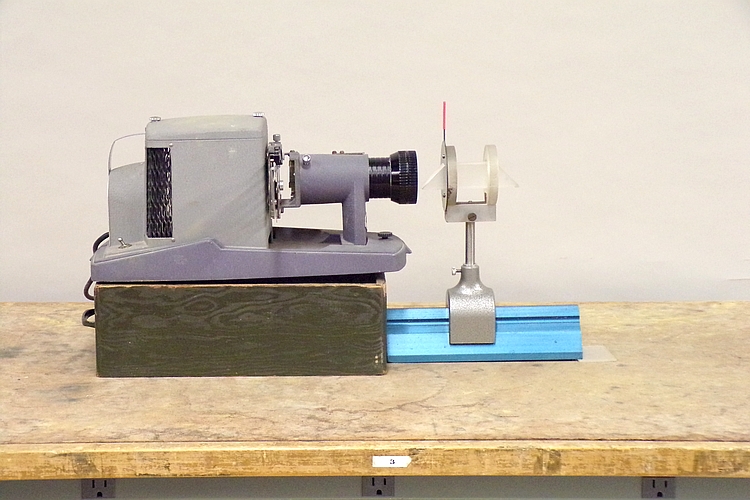
Inserted in the projector is a slide with an image of Broida Hall, which appears right side up on a screen. In front of the projector is a dove prism, which is mounted so that you can rotate it about its long axis by means of the red tab at one end of the mount. When you place the prism in the beam from the projector as shown, the image on the screen is inverted. When you rotate the prism, the image rotates at twice the rate at which you rotate the prism. (The piece of plastic under the edge of the rail allows alignment of the inverted image with the original image.)
A dove prism has similar geometry to that of a right-angle prism oriented to act as an inverting prism, but without the extra glass on top. (See demonstration 80.24 -- Slide refracted through prism.) When light passes from air into glass at a non-zero angle of incidence, it is refracted toward the normal to the surface of the glass. In the dove prism oriented as shown above, then, rays from the projector are bent downward as they enter the prism. Since they meet the bottom face of the prism at an angle that is greater than the critical angle, they suffer total internal reflection and exit through the opposite face of the prism. (See Demonstration 80.18 -- Refraction tank.) The diagram below shows the paths that rays coming from the top and bottom of an object take as they pass through the prism to form an image.
We see that the image of the object is inverted. Since the rays are refracted only in the vertical direction, the image is unchanged along the horizontal axis. That is, it is inverted, but not reversed from left to right. This is equivalent to reflecting the image across a mirror plane parallel to the top and bottom faces of the prism (i.e., horizontal when the prism is oriented as shown above). Since relative to the incident rays, rays reflected from a mirror lie at twice the angle of incidence, when you rotate the dove prism about its long axis, the image rotates at twice the rate at which you rotate the prism. We can also see that with the prism oriented as shown above and with it rotated 180 degrees, the image is inverted, but when the red tab is rotated 90 degrees in either direction, the image is flipped from left to right, but is right side up. Thus, when you start with the prism as shown above, as you rotate it though an angle of 180 degrees, the image makes one full rotation, and when you continue rotating for another 180 degrees, the image makes another full rotation. The red tab provides a handle by which you can rotate the prism, and also makes it easy for the class to see its orientation.
